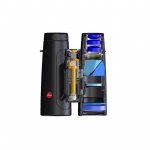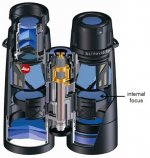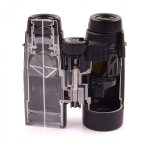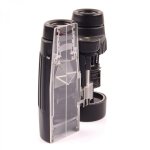-
Welcome to BirdForum, the internet's largest birding community with thousands of members from all over the world. The forums are dedicated to wild birds, birding, binoculars and equipment and all that goes with it.
Please register for an account to take part in the discussions in the forum, post your pictures in the gallery and more.
You are using an out of date browser. It may not display this or other websites correctly.
You should upgrade or use an alternative browser.
You should upgrade or use an alternative browser.
Trinovid (1 Viewer)
- Thread starter dries1
- Start date
More options
Who Replied?NDhunter
Experienced observer

Tenex,
When I have some time I will compare the Trinovid 8X42 and the Ultravid 8X42 HD. Off the bat the Trinovid has a slightly smaller FOV.
Andy W.
Andy:
If you go back on the Leica subforum, there are lots of posts and comparisons and reviews of this Trinovid and the Trinovid HD. Read some of those and learn more.
I have owned this model Trinovid you are referring to, and you can find my thoughts a while back on the forum,
This Trinovid seems to be simply a reincarnated Ultravid BR, with similar optics.
The Trinovid lacks in brightness to both the Trinovid HD, and the Ultravid HD, where both models step things up, optically.
I think that is why this model was not around long, it was an orphan with
no real reason to stay in the Leica lineup.
Jerry
"Read some of those and learn more."
A bit blunt tonight eh?
Andy W.
LOL.
Jerry can come across as a bit 'brusque'.
But in this case I am sure he was just pointing you in the direction of helpful info, hence his further comments in the same post which certainly wouldn't have been there if 'being blunt' was actually his aim.
I tend to use 10 words where 5 would do the job, Jerry is often more 'economical' .
Lee
dries1
Member
Thanks Lee, I understand that there is info on the Trinovids, but it is limited, (Nothing there about the specific comments from Tenex) and since the information is "subjective" - others opinions, I will to find out for myself and keep my findings in-house. Nothing like having ones own opinions.
Andy W.
Andy W.
Curiously, nobody seems to comment on the unusual (for Leica) optical design of the 2011-15 Trinovid which is what struck me most about it. It offered a somewhat flatter field than the Ultravid, at the cost of worse falloff near the edges and a mildly odd effect when panning (surely less obvious than the infamous RB of early Swarovision). I thought it was a promising experiment for such a conservative company, though Leica clearly decided otherwise.
Here's a cutaway of the 2011-15 10x42 Trinovid and 7x42 Ultravid. No field flattener elements between prisms and eyepiece, the plane of focus is curved rather than planar.
Both are very similar designs although it seems likely the more expensive optic used lower-dispersion glass types from the Corning Inc. catalogue.
Both have pincushion distortion dialled in to stop distracting stretching when panning. Pincushion was originally specified by the military to aid spotting camouflaged targets when panning.
Leica have long espoused that some pincushion distortion and field curvature help give a three dimensional and transparent view.
Attachments
Last edited:
Mike F
Well-known member
Leica have long espoused that some pincushion distortion and field curvature help give a three dimensional and transparent view.
And let's hope that they are never seduced by the idea that they might get a larger market share by producing binos with a flat field!
NDhunter
Experienced observer

"Read some of those and learn more."
A bit blunt tonight eh?
Andy W.
Andy:
I'm very sorry I hurt your feelings. :eek!:
Did you go ahead and read more ? Live and learn, there is lots of information
on Birdforum, especially some years back.
Jerry
dries1
Member
Thanks Jerry, I have thick skin, I was just busting your chops. Right now I am on a bit of break, our horizontal drill to install a 20 inch pipe over a mile in the ground did not work out, so back to the drawing board. Currently I am enjoying the 2011-2015 Trinovids (don't know how to otherwise distinguish them from the BNs and the HDs), and some other new to me, large aperture Ultravids.
AW
AW
tenex
reality-based
This Trinovid seems to be simply a reincarnated Ultravid BR, with similar optics.
Perhaps the 8x is more similar to the Ultravid than the 10x I'm familiar with?
saidentary
Active member
I have the Trinovid 10x50 BA binoculars that I bought new in the mid 1990's. I still think that they're great. At the time, they were significantly better than the Zeiss and Nikon models (I don't remember the exact models, but the Nikons were about 300-400 dollars whereas the Zeiss were priced comparably to the Leicas) that I looked through. I remember a Canon image stabilized model, but it (obviously) wasn't the newer 10x42 with the better glass. I remember the image stabilization was great but the optics, although good, were significantly inferior those of the Leicas.
The comments that people have made about field flatness and Leica's alleged lack thereof are at odds with my own perception. To me the Leicas were the ones with a flat field of view out to the edge (or very nearly so) whereas it was the Zeiss and the Nikon that both showed significant (and to me unacceptable) field curvature.
I bought the Leicas and still have them. They were something like 1200 or 1400 dollars and I felt worth every penny. The only binos that I personally have ever seen that were superior were some Swarovski model I saw at Bass Pro Shop or Cabela's in Florida several years ago. At the time, I didn't think they were enough better to warrant the price, which was somewhere in the neighborhood of $2000, if I remember correctly (which I may not).
I've thought about "upgrading" to something like Swarovski EL SV 10x50 binoculars and/or Canon 10x42 L IS binoculars, but I get the impression that the Trinovid 10x50 BA binoculars are still so good that any improvements would be incremental, at best--or at worst, even marginal. What do you folks think?
The comments that people have made about field flatness and Leica's alleged lack thereof are at odds with my own perception. To me the Leicas were the ones with a flat field of view out to the edge (or very nearly so) whereas it was the Zeiss and the Nikon that both showed significant (and to me unacceptable) field curvature.
I bought the Leicas and still have them. They were something like 1200 or 1400 dollars and I felt worth every penny. The only binos that I personally have ever seen that were superior were some Swarovski model I saw at Bass Pro Shop or Cabela's in Florida several years ago. At the time, I didn't think they were enough better to warrant the price, which was somewhere in the neighborhood of $2000, if I remember correctly (which I may not).
I've thought about "upgrading" to something like Swarovski EL SV 10x50 binoculars and/or Canon 10x42 L IS binoculars, but I get the impression that the Trinovid 10x50 BA binoculars are still so good that any improvements would be incremental, at best--or at worst, even marginal. What do you folks think?
I have had both and I feel the Swarovski SV 10x50's are definitely better if you like flat fields and perfectly sharp edges and it has more 3D IMO than it's smaller sibling's. But that being said you said you tried the SV's and you didn't feel they were worth the extra money so you have made the decision yourself. There are diminishing returns in the performance of binoculars and the Trinovids are already very good binoculars . IMO there is not a lot of difference between the Trinovids and the Ultravids within the Leica line. The Leica's have their advantages also which is a little better glare control and nice saturated colors. The best thing would be to compare yours side by side with an SV to see what suits you the best.
Last edited:
saidentary
Active member
I have had both and I feel the Swarovski SV 10x50's are definitely better because of the perfectly sharp edges and they are going to be brighter because of better glass and dielectric prism coatings. But that being said you said you tried the SV's and you didn't feel they were worth the extra money so you have made the decision yourself. There are diminishing returns in the performance of binoculars and the Trinovids are already very good binoculars . IMO there is not a lot of difference between the Trinovids and the Ultravids within the Leica line. The SV 10x50's are probably the best binocular in the 10x50 format. It all depends if you have to have the best or is very good, good enough.
Thank you. That's quite helpful.
I had suspected the SV 10x50's were probably the best (with the possible exception of the Nikon 10x50 WX at ~$6400....) in that format based on what I've read in various forums on this and other sites. I don't know whether the model I tried in the store was one from the SV line or not. It was a while ago.
Last edited:
dries1
Member
The EL SV 10X50 is a good glass, but to me it is not the brightest glass, and it does suffer from ghosting at night. Just because it has a flat view and sharp edge to edge does not make it the best for everyone. The Leica UVHD+ handles ghosting and stray light better and provides a great immersive view IMHO.
I have several Swarovski glass, and they are excellent, but there has been no decision that they are the best hands down. I am sure the BA 10X50 is also a great glass, I would totally enjoy it as a 10X50.
Dennis not everyone wants a FLAT VIEW all the time like you, so stop stacking BBBBBBBBBBs
Andy W.
I have several Swarovski glass, and they are excellent, but there has been no decision that they are the best hands down. I am sure the BA 10X50 is also a great glass, I would totally enjoy it as a 10X50.
Dennis not everyone wants a FLAT VIEW all the time like you, so stop stacking BBBBBBBBBBs
Andy W.
dries1
Member
Just a follow up without editing my previous post. It really depends what one uses the glass for, everyone likes a flat view for the night sky, I am in that camp, however for terrestrial the Leica UVHD+ is a great glass providing views comparable with the best, and if one is not susceptible to CA, they also handle really well. Just try before you buy.
Andy W.
Andy W.
Andy. I agree with you. I edited my post. I forget sometimes that the flat field of the SV is not for everybody. I like the Leica view also and your correct in that it is immersive and probably a little better for stray light. The 10x50 SV is pretty immersive though with it's big 66 degree AFOV for a 10x which is the same as the UVHD and handles stray light a little better than it's smaller siblings and CA a little better than the UVHD. I also agree that the SV with it's flat field is better for astro use than the Leica UVHD +. One thing I like about Leica's is their saturated colors. Like Gilmore Girl says the view is pretty. That description is perfect.
Last edited:
To my eyes, the 10x50 has been the best Leica binocular since the introduction of the Trinovid BA. It has a wide, sharp view and much better edge performance than the 42mm models or the 8x50. It is quite close in performance to modern top guns, with the main difference being in lower light transmission and somewhat less neutral colours.
If you were to "upgrade" to an SV 10x50 you would notice incremental improvements in colour, brightness and contrast, and some improvement in edge sharpness but with the tradeoff of somewhat less natural feeling view. If you were to upgrade to the Canon 10x42 L IS, you would get the benefit of a superb image stabilisation system along with marginal improvements in colour, brightness and contrast. For me, IS is such a huge benefit that I would not consider a non-stabilised binocular for my primary use any longer, but peoples' preferences vary. I see 30-40% more detail with the IS L than with any non-stabilised glass, and that seals the deal for me.
Kimmo
If you were to "upgrade" to an SV 10x50 you would notice incremental improvements in colour, brightness and contrast, and some improvement in edge sharpness but with the tradeoff of somewhat less natural feeling view. If you were to upgrade to the Canon 10x42 L IS, you would get the benefit of a superb image stabilisation system along with marginal improvements in colour, brightness and contrast. For me, IS is such a huge benefit that I would not consider a non-stabilised binocular for my primary use any longer, but peoples' preferences vary. I see 30-40% more detail with the IS L than with any non-stabilised glass, and that seals the deal for me.
Kimmo
Similar threads
Users who are viewing this thread
Total: 2 (members: 0, guests: 2)







